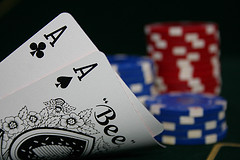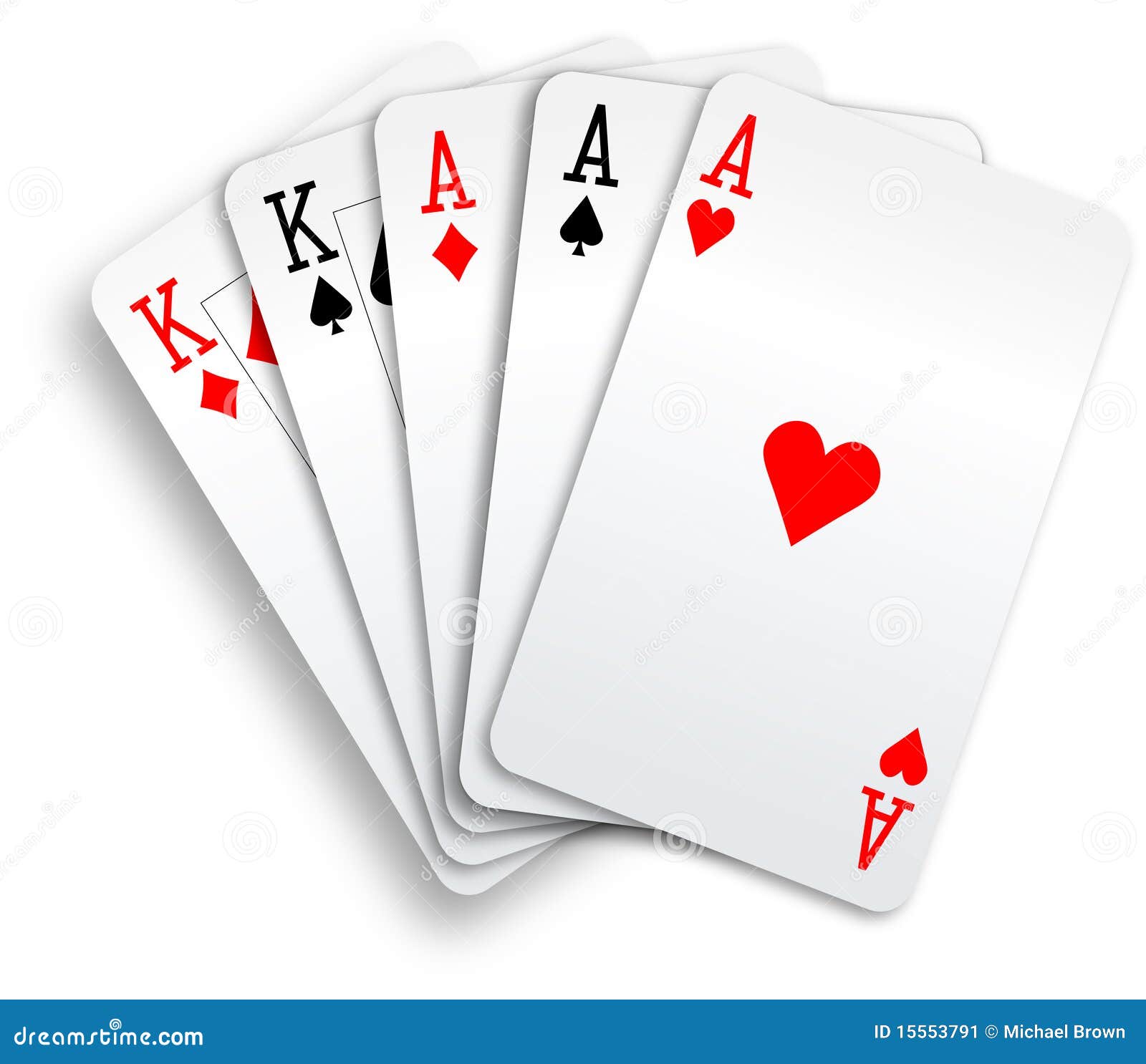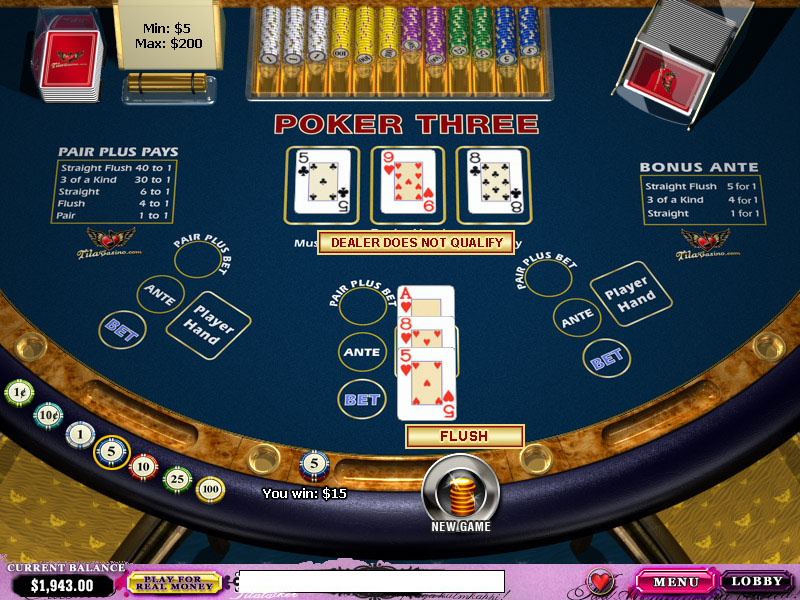Brian Alspach
17 January 2000
Abstract:
Once again, having three pair in your poker hand would require six cards, which is a technical impossibility. If you have six cards in your poker hand, you are either on the verge of having someone confront you as a cheater, or someone cannot count. However, if you are playing Omaha, the three pair poker hand.
There are a few 6-card poker games so it is worth looking at probabilitiesfor winning with certain kinds of hands. One chooses the highest ranked5-card poker hand among the 6 cards and values the hand based on the5-card hand. The types of 5-card poker hands in decreasing rank are
- straight flush
- 4-of-a-kind
- full house
- flush
- straight
- 3-of-a-kind
- two pairs
- a pair
- high card
The total number of 6-card poker hands is .
- If you have no pair, three of a kind, straight, flush, full house, etc., then the highest card in your hand is considered to be decisive. The hand above, in which the best card is a king and there is no other combination of poker hand, is known as “king-high”. Ace high beats king high. King high beats queen high, and so on.
- Poker Rules FAQ - Q - Who wins if two players are holding a flush? A - If two or more players have five cards of the same suit, the player with the strongest cards wins. For example - if Player A is holding 10 ♥ Q ♥, player B is holding 4 ♣and 6♥ and the board shows 3♥7♥5♥9♥J♦, player A with Q♥10♥9♥7♥5♥ wins over player B with 9♥7♥6♥5♥3♥.
A straight flush is completely determined once the smallest card in thestraight flush is known. There are 40 cards eligible to be the smallestcard in a straight flush. If the smallest card in the straight flush isan ace, then the sixth card may be any of 47 cards. If the smallest cardin the straight flush is any of the other 36 eligible beginning cards,then the sixth card may be any of 46 cards because we cannot use the nextsmallest card in the same suit as the straight flush. Hence, there are6-card hands containing straight flushes.
In forming a 4-of-a-kind hand, there are 13 choices for the rank ofthe quads, 1 choice for the 4 cards of the given rank, and choices for the remaining 2 cards. This implies there are 4-of-a-kind hands.

There are 2 ways to get a full house and we count them separately. Oneway of obtaining a full house is for the 6-card hand to contain 2 setsof triples. There are ways to choose the 2 ranksand 4 ways to choose each of the triples. This gives us full houses of this type. The other way of getting a full houseis for the 6-card hand to contain a triple, a pair and a remaining card ofa third rank. There are 13 choices for the rank of the triple, 12 choicesfor the rank of the pair, and 44 choices for the singleton card. Thereare 4 ways of choosing the triple of a given rank and 6 ways to choose thepair of the other rank. This produces full houses of the latter type. Adding the two numbersyields 165,984 full houses.
To count the number of flushes, we obtain 6-card hands formed from cards in the same suit. Altogether, thereare flushes with 6 cards in the same suit.There are choices for 5 cards in the same suit.There are then 39 choices for a sixth card from a different suit. Thus,there are flushes in 6-card hands, whereprecisely 5 cards are in the same suit. Combining the two gives us207,636 6-card hands containing flushes. Of these, 1,844 are straightflushes whose removal leaves 205,792 flushes.
Let's determine how many sets of 6 distinct ranks correspond to straights.One possible form is ,where x can be any of9 ranks. The other possible form is ,where yis neither x-1 nor x+5. When x is ace or 10, then there are 7choices for y. When x is between 2 and 9, inclusive, there are 6choices for y. This implies there are sets of 6 distinct ranks corresponding to straights. There are then 4choices for each card of the given ranks except we must remove thosechoices producing flushes. There are 4 choices giving all 6 cards inthe same suit. If 5 are in the same suit, there are choices of which 5 ranks will be in the same suit, 4 choicesfor the suit of the 5 cards, and 3 choices for the suit of the remainingcard. So there are choices which give aflush. This means there are 46 - 76 = 4,020 choices not producing aflush. Hence, there are straights of thisform.
We also can have a set of 5 distinct ranks producing a straight whichmeans the corresponding 6-card hand must contain a pair as well. Thereare 10 sets of ranks of the form .There are 5choices of the rank to be paired, 6 choices for the pair, and 4 choicesfor each of the other 4 cards except not all 4 cards can be chosen inthe same suit as either of the cards in the pair. This means there are44 - 2 = 254 choices for the 4 cards. We then have straights of this form. Altogether there are361,620 straights.
In forming a 3-of-a-kind hand, there must be a triple and 3 other cardsall of distinct ranks different from the rank of the triple. There are13 choices for the rank of the triple, and there are choices for the ranks of the other 3 cards. There are 4 choicesfor the triple of the given rank and there are 4 choices for each of thecards of the remaining 3 ranks. Altogether, we have 3-of-a-kind hands.
Poker Hand 2 Pair
Next we consider two pairs hands. Such a hand may contain either threepairs, or two pairs plus two remaining cards of distinct ranks. Weevaluate these 2 types of hands separately. If the hand has threepairs, there are ways to choose the ranks ofthe pairs and 6 ways to choose each of the pairs. This produces6-card hands with three pairs.
Poker Hands 3 Pairs
For the other kind of two pairs hand, there are choices for the two ranks of the pairs and there are ways to choose the ranks of the 2 singletons. There are 6 choicesfor each of the pairs, and there are 4 choices for each of the remaining2 cards. This produces hands of two pairs of the second type. Adding the two gives 2,532,8166-card hands with two pairs.
Now we count the number of hands with a pair. Such a hand must have5 distinct ranks. There are possible setsof 5 ranks. We must remove sets of the form because these correspond to straights. There are 10 such sets leaving1,277 sets of ranks corresponding to a hand with one pair. Given sucha set, there are 5 choices for the rank of the pair, and 6 choices fora pair of the chosen rank. There are 4 choices for each of the remaining4 cards except we cannot choose all 4 to be in the same suit as eitherof the cards forming the pair. Hence, there are 44-2 = 254 choicesfor the remaining 4 cards. This gives us hands with a pair.
We could determine the number of high card hands by removing the handswhich have already been counted in one of the previous categories.Instead, let us count them independently and see if the numbers sumto 20,358,520 which will serve as a check on our arithmetic.
A high card hand has 6 distinct ranks, but does not include straights.So we must eliminate sets of ranks which have 5 consecutive ranks. Indetermining the number of straights above, we derived that there are 71sets of 6 distinct ranks which give straights. There are sets of 6 distinct ranks. Removing the 71 sets correspondingto straights, leaves 1,645 sets of distinct ranks which do not producestraights. There are 4 choices for each of the 6 cards in a given setproducing 46 = 4,096 ways of choosing cards for a given set of ranks.However, some of the choices produce flushes and we must remove them.Clearly there are 4 ways of choosing the 6 cards all in the same suitwhich is one way of getting a flush. There 6 ways of choosing 5 of theranks and 4 choices for the suit of these 5 ranks, and 3 choices for thesuit of the remaining card. This gives us choices of suits which produce a flush with 5 cards in the same suit.We remove these 76 choices which produce flushes giving us 4,020 choicesfor the 6 cards which do not produce a flush. Multiplying 4,020 by 1,645gives 6,612,900 high card hands.

If we sum the preceding numbers, we obtain 20,358,520 and we can be confidentthe numbers are correct.
Here is a table summarizing the number of 6-card poker hands. Theprobability is the probability of having the hand dealt to you whendealt 6 cards.

| hand | number | Probability |
| straight flush | 1,844 | .000091 |
| 4-of-a-kind | 14,664 | .00072 |
| full house | 165,984 | .00815 |
| flush | 205,792 | .0101 |
| straight | 361,620 | .0178 |
| 3-of-a-kind | 732,160 | .036 |
| two pairs | 2,532,816 | .1244 |
| pair | 9,730,740 | .478 |
| high card | 6,612,900 | .325 |
You will observe that you are less likely to be dealt a hand withno pair (or better) than to be dealt a hand with one pair. Thishas caused some people to query the ranking of these two hands.In fact, if you were ranking 6-card hands based on 6 cards, theorder of the last 2 would switch. However, you are basing the rankingon 5 cards so that if you were to rank a high card hand higher than a handwith a single pair, people would choose to ignore the pair in a6-card hand with a single pair and call it a high card hand. Thiswould have the effect of creating the following distortion. Thereare 16,343,640 6-card hands containing 5 cards which are high cardhands. Of these 16,343,640 hands, 9,730,740 also contain 5-cardhands which have a pair. Thus, the latter hands are more specialand should be ranked higher (as they indeed are) but would not beunder the scheme being discussed in this paragraph.
last updated 12 January 2000